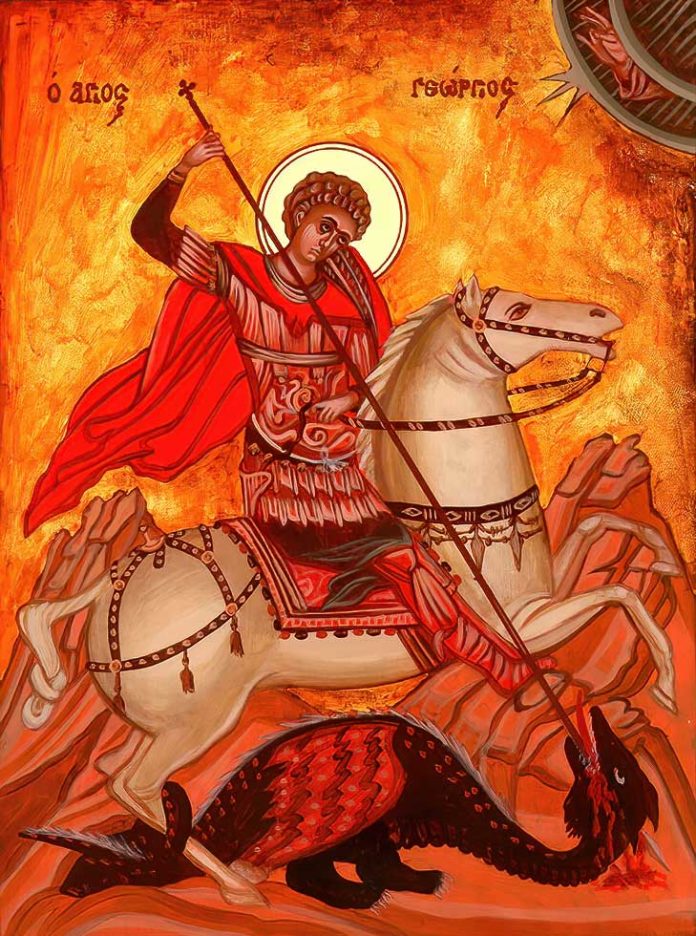On the sixth of May, the Bulgarian Orthodox Church honors Saint George the Victorious on Gergiovden. Georgi, a courageous martyr for the Christian faith, was celebrated as a warrior saint and revered as a guardian of various military ranks and a helper in battles. In the New Julian calendar, this particular day falls on a date set according to the Gregorian calendar around the beginning of the 20th century. In countries where the Julian calendar tradition is still observed (e.g., the United Kingdom), the commemoration typically takes place on April 23rd, believed to be the day of Saint George’s beheading under the orders of the ancient Roman emperor Diocletian. To avoid clashing with Easter celebrations, the date may sometimes be adjusted.
Name Day’s Celebrations
St. George’s Day is celebrated as the name day for Georgi, Gencho, Gergana, Gergina, Ginka, Ganka, Ganya (Gana, Ganka), Gancho, Georgiya, Gabriela, Gabriel, and their variations, ranked as the fifth most celebrated holiday in Bulgaria. It follows Palm Sunday, Midsummer Day, Archangel’s Day, and Stephen’s Day. Around 235,243 people celebrate this special day.
St. George’s Day holds a special place in the Bulgarian national calendar as the most revered spring holiday, surpassing even Easter. Often referred to as Gergiovden (Гергевден, Гърговден), this celebration on May 6th marks the beginning of the summer half of the financial year, which concludes on Dimitrovden. Rich in rituals and traditions, St. George’s Day promotes health, fertility, and prosperity in all aspects of life.
Origins of Gergiovden
Numerous hypotheses surround the holiday’s origin, with some suggesting links to ancient Thracian or Slavic celebrations, while others propose connections to Asia and the customs of the proto-Bulgarians. St. George’s Day has drawn parallels with various ancient beliefs and artifacts, such as the Thracian Heros and the Knights of the Round Table. Over the centuries, the holiday has been influenced by diverse cultural interactions.
Traditionally, St. George is considered the guardian of spring moisture and fertility, unlocking springs and overseeing fields and crops. He is also the patron saint of farmers and shepherds, making St. George’s Day synonymous with Shepherd’s Day. The offering of sacrifices on this day is a vital celebration characteristic.
The Magic of the Morning Dew and Water
Embracing the magic of dew and water, St. George’s Day sees a cherished tradition of connecting with nature during the early morning hours, just before the first rooster crows. People visit secluded grassy areas to immerse themselves in the morning dew, a ritual known as “bathing.” Rolling in the dew, often unclothed, is believed to enhance fertility and bless the land with a gentle touch.
Some prefer to walk barefoot on the dew-covered grass or cleanse their faces and hands, while others may even drink the dew. This ritual is thought to bring health and vitality throughout the year and alleviate lower back pain. Infertile women also partake in the dew bathing tradition, hoping to attain fertility.
Collecting dew on St. George’s Day is believed to harness its extraordinary healing power. Beyond dew bathing, ritualistic immersion in rivers and springs is also practiced. After their dew walk, Muslim Bulgarians in Chepelare visit St. Georgi’s shrine to wash or bathe. This custom, prevalent across the Rhodopes and other regions, often involves bringing home water gathered during these rituals, which is then used to mix ritual bread.
Much like Easter, rain on St. George’s Day is considered especially fruitful, with each raindrop carrying the potential for life and abundance.
The Festive Table on Gergiovden
The festive table on St. George’s Day is a community celebration shared amongst family and friends. The table symbolizes unity and tradition when gathered in open spaces amidst nature’s beauty, near a shrine, chapel, or monastery. Consecrated with blessings, it is laden with delectable treats like roasted lamb, ritual bread, fresh milk and cheese, and newly harvested garlic – a must-have on this special day.
The traditional food on Gergiovden is lamb – the whole St. George’s Day lamb is roasted. Gergiovden’s bread is large, round, and intricately decorated with dough patterns on top, often depicting shepherds, sheepdogs, or a flock of sheep. The roasted lamb and baked bread are taken to the church to be blessed by the priest.
Traditionally, the festive table, a communal celebration, is set up in the open air and adorned with roasted lamb, bread, and other foods such as fresh milk, sour milk, cheese, and fresh garlic. Songs, music, and dances accompany the meal while games and competitions are arranged.
Throughout the day, St. George’s Day songs and dances celebrate the triumph of St. George over the dragon, unlocking the waters and fertility. The traditional St. George’s swings, tied to a green tree, are a must; the higher they swing, the taller the crops will grow, ensuring a bountiful season ahead.
The Day of Courage and the Bulgarian Army
The Day of Courage and the Bulgarian Army is celebrated on the 6th of May. It is an inspiring testament to the strength and resilience of the Bulgarian spirit. Since its inception by Prince Alexander I of Battenberg, this remarkable celebration has honored the brave feats of the battlefield and the unwavering dedication of the servicemen. Through challenges and changes, this enduring holiday has become a powerful symbol of Bulgaria’s military history, exemplifying the courage and determination that defines the nation.



